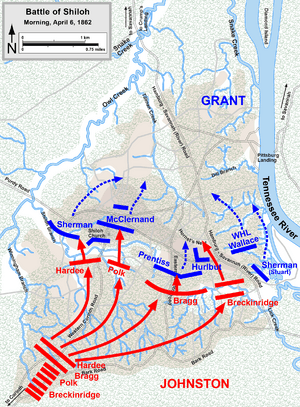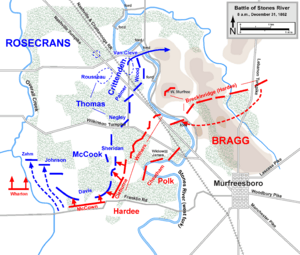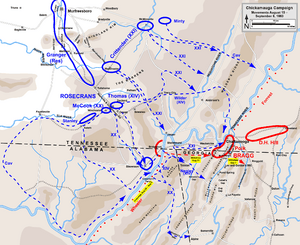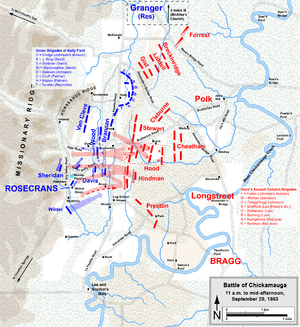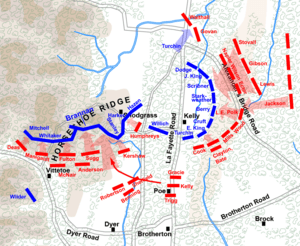John G. Coltart facts for kids
Quick facts for kids
John Gordon Coltart
|
|
|---|---|
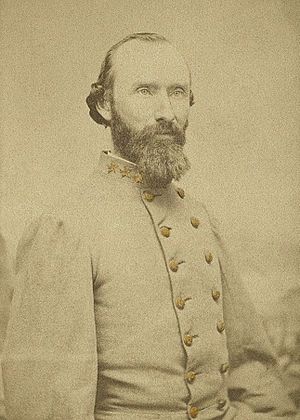
A wartime carte-de-visite of Coltart
|
|
| Born | January 27, 1826 Huntsville, Alabama |
| Died | April 16, 1868 (aged 42) Tuscaloosa, Alabama |
| Buried |
Maple Hill Cemetery
|
| Allegiance | Confederate States of America |
| Service/ |
Confederate States Army |
| Years of service | 1861–1865 |
| Rank | Colonel |
| Commands held |
|
| Battles/wars | |
| Other work | Businessman, county sheriff |
John Gordon Coltart (January 27, 1826 – April 16, 1868) was an officer in the Confederate States Army during the American Civil War. He led different groups of soldiers, from small battalions to larger divisions.
Before the war, Coltart was a successful businessman in Huntsville, Alabama. He also led a local group of volunteer soldiers. When the war began, he quickly rose through the ranks. He was a lieutenant colonel and then a colonel of the 7th Alabama Infantry Regiment. Later, he commanded the 26th Alabama Infantry Regiment, which became the 50th Alabama Infantry Regiment.
Coltart fought in many major battles, including Shiloh, Stones River, Chickamauga, and the Atlanta Campaign. He was wounded several times while leading his troops. After the war, he briefly served as a county sheriff. He passed away a few years later.
Contents
Early Life & Business
John Gordon Coltart was born on January 27, 1826, in Huntsville, Alabama. His father, Samuel Coltart, was an immigrant from Scotland and helped found the town. Samuel had also been the mayor of Huntsville.
As a young man, John Coltart became a bookseller, a druggist, and an insurance agent in Huntsville. He was very good at business and became quite wealthy. In 1855, he started and led a local group of volunteer soldiers called the Madison Rifles. This group was very well-respected in the community. His brother, Robert, was also a part of this group, serving as a first sergeant.
American Civil War
Early War: Pensacola & Discipline
When Alabama decided to leave the United States, Coltart's Madison Rifles joined the state's military. They went to Mobile and then to Pensacola, Florida. There, they joined Confederate forces who were trying to capture Fort Pickens, which was held by Union troops.
On April 2, 1861, Coltart was chosen as the lieutenant colonel of the 3rd Alabama Battalion. His Madison Rifles company became Company E within this battalion. The battalion later grew into the 7th Alabama Infantry Regiment, and Coltart was re-elected as lieutenant colonel on May 18.
The 7th Alabama spent most of 1861 building defenses in Pensacola. It was a relatively quiet time, and more soldiers died from sickness than from fighting. Coltart often commanded the regiment because its colonel, S. A. M. Wood, was frequently away. Coltart was known for being very strict, which made him unpopular with his soldiers. One soldier said Coltart was a "good military man" but didn't inspire confidence. However, soldiers also believed he was very brave in battle.
In November, the 7th Alabama moved to Chattanooga, Tennessee. Their mission was to stop a rebellion by people in East Tennessee who supported the Union. Coltart led the regiment in trying to break up a guerrilla camp and rounding up suspected Union supporters. While near Chattanooga, Coltart's strict rules, like limiting when soldiers could get wood and water, almost caused a mutiny in his old company.
The regiment then joined the Confederate Army in Bowling Green, Kentucky in December. They spent the winter doing routine duties and building more defenses. When Colonel Wood was promoted, Coltart became the colonel of the regiment on February 5, 1862.
Later that month, the 7th Alabama helped protect the army as it retreated to Corinth, Mississippi. In March, as the soldiers' enlistment times were ending, many refused to re-enlist under Coltart. They didn't like his strict leadership. Coltart blamed the officers, saying they wanted higher positions. Despite offers of good re-enlistment bonuses, the regiment was disbanded in late March. Most of its soldiers joined other Alabama units.
Shiloh & Corinth Battles
Just before the Battle of Shiloh began, Coltart became the colonel of the new 26th Alabama Regiment. He took command on April 3. This regiment was still quite new and had only 440 soldiers ready for Shiloh. The 26th Alabama was part of Gladden's brigade, which was in Bragg's Corps.
On the morning of April 6, Gladden's brigade became disorganized while moving towards the battle. The 26th Alabama ended up on the far right of the brigade. Around 8:00 a.m., they charged Miller's brigade in the Spain Field. The regiment was "hotly engaged" and fought hard, helping Gladden's Brigade push back the Union troops and capture their camp.
The 26th Alabama then stopped for almost an hour near the captured camp, under heavy artillery fire. When they attacked again, they moved into an open field. Here, Coltart was badly wounded in the foot, and his regiment suffered many losses.
Lieutenant Colonel William D. Chadick took over command of the regiment. Coltart briefly returned to advise Chadick to retreat because the regiment was exhausted, but Chadick decided to keep fighting. Coltart's wound was too severe, and he had to leave the battlefield for treatment. The 26th Alabama had lost more than half its men on the first day. Coltart had to return to Corinth for treatment before the second day of fighting began.
After the battle, the Confederates retreated to Corinth. During the withdrawal from the city, Coltart led the 26th Alabama in rear-guard actions. They fought small skirmishes and burned bridges to slow down the Union pursuit.
Kentucky & Stones River
In August 1862, Coltart led the 26th Alabama during the Confederate invasion of Kentucky. However, his division was separated from the main army and missed the major Battle of Perryville.
By December, Coltart's regiment was part of Loomis' Brigade in the Army of Tennessee. On December 30, the day before the Battle of Stones River began, the 26th Alabama helped stop a Union advance.
On the morning of December 31, Loomis' Brigade attacked. The 26th Alabama advanced on the left side of the brigade. Loomis was wounded early in the attack, and command of the brigade fell to Coltart. Despite heavy losses, the brigade pushed forward, driving back some Union regiments. Coltart reported that his lines were hit hard by enemy fire. The Union troops counterattacked, pushing parts of Coltart's brigade back.
On the night of January 2–3, Coltart's Brigade moved to support another brigade, preparing for a new attack. On the morning of January 3, Coltart's Brigade helped push Union troops out of the Round Forest. Both sides fought small skirmishes throughout the day. At dusk, Union troops attacked again, forcing Coltart's and White's Brigades to retreat. However, the Union troops soon left their gains, allowing the Confederates to take back their positions. Fearing more Union soldiers and with the rising Stones River threatening to divide his army, General Bragg decided to retreat.
Chickamauga & Chattanooga
In early 1863, the 26th Alabama was combined with another regiment, leaving Coltart without a command. He was then assigned to help with conscription (drafting soldiers) in East Tennessee and Western North Carolina. The 26th Alabama was later separated and renamed the 50th Alabama on June 6. Coltart returned to command the regiment by July.
During this time, the army retreated to LaFayette. On August 19, Coltart's 50th Alabama was sent to guard the Brown's Ferry crossing on the Tennessee River, which was seen as a very important location.
The armies clashed in the Battle of Chickamauga on September 19 and 20. On September 18, the 50th Alabama supported an artillery battery, facing enemy fire but with only one soldier slightly wounded.
On September 20, Coltart's regiment was on the left of its brigade. They faced Carlin's Brigade. The Union line broke, and the 50th Alabama reached the enemy's defenses, driving them back in confusion. A soldier from the 50th Alabama even captured a flag from a Union artillery battery.
Coltart's regiment had advanced so quickly that they were accidentally hit by friendly fire from another Confederate regiment. They then stopped to rejoin their brigade.
Later, Coltart's division joined the attack on Horseshoe Ridge. The 50th Alabama was between two other Alabama regiments. They faced intense fire from Union artillery and soldiers. Coltart described it as "such a terrible fire of musketry and grape that we were compelled to fall back." Coltart and other commanders tried to charge again, but they couldn't reach the Union lines. The 50th Alabama couldn't be rallied for a third charge. Horseshoe Ridge was eventually captured, but Coltart's brigade was out of the fight for the rest of the battle. The 50th Alabama lost 105 out of about 313 soldiers in the battle.
In the Chattanooga campaign that followed, Coltart's regiment fought in the Battle of Missionary Ridge. The Confederate forces were outnumbered and in a poor position. They were defeated by the Union attack on November 25, and Coltart's regiment lost 45 men, mostly captured.
Atlanta Campaign & Later Battles
The army spent the winter of 1863–1864 in Dalton, Georgia. Coltart led his regiment during the early parts of the Atlanta campaign. By June 30, he was back in command of his brigade because General Deas was ill. During this time, the brigade fought in battles like Resaca, New Hope Church, and Kolb's Farm.
On July 22, during the Battle of Atlanta, Coltart's brigade attacked. They drove off Union pickets but lost alignment with another brigade. They ended up attacking a weaker part of the Union line. Despite this, Coltart's troops were pushed back twice before another Confederate brigade broke through and helped them. However, their gains were temporary, and Coltart's brigade was soon driven back by a Union counterattack.
Coltart returned to commanding his regiment when another colonel was promoted to brigade command. For the Battle of Ezra Church on July 28, Coltart was wounded as the attack began, but he continued to lead the 50th Alabama. The brigade commander was also wounded, and command fell to Coltart again. However, Coltart himself was soon forced out of the fight by his wound. The attack was called off after only fifteen minutes. Coltart was out of action for the rest of the campaign. He returned to command the 50th Alabama by September 20.
During Hood's invasion of Tennessee, the 50th Alabama suffered heavy losses at the Battle of Franklin on November 30. Coltart's regiment also fought in the Battle of Nashville, where his brigade retreated quickly against a Union attack on December 15.
By January 1865, Coltart's unit was in Augusta, Georgia. On January 29, he led 900 men to reinforce another general. When the remains of the Army of Tennessee reached Kinston on March 7, Coltart became commander of Hill's Division. This "division" was very small, with only 562 effective soldiers for the upcoming Battle of Wyse Fork.
On March 8, after another Confederate division broke through Union lines, Hill personally led Coltart's division in an attack. They routed the Union opposition and cut off their retreat. However, General Bragg stopped the attack before they could win completely. Coltart's division played a supporting role on March 9. On March 10, they covered Hill's left flank. The Confederates withdrew that night.
Coltart continued to command the division in the Battle of Bentonville, the last major attack of Johnston's army. On March 19, Hill led Coltart's Division in an attack on the rear and left of Morgan's Division. The Confederates were successful at first, but a Union counterattack turned the tide. Hill's troops were defeated. The Confederate line was re-established, but Hill's Corps did not see much more action in the battle, which ended in another retreat. Coltart was left without a command when the army was reorganized on April 9. After Johnston's army surrendered, Coltart was released on May 15.
After the War
After the war, Coltart returned to Huntsville. In July 1866, he was appointed sheriff of Madison County, Alabama. However, when military rule began in the former Confederate states in 1867, Coltart was removed from his position. This was because he had been a Confederate officer. His brother, Robert, was also removed as mayor of Huntsville for the same reason.
In early 1868, Coltart went to a state health facility in Tuscaloosa, Alabama, at his own request. He passed away there on April 16, 1868. He was buried at Maple Hill Cemetery in Huntsville.


